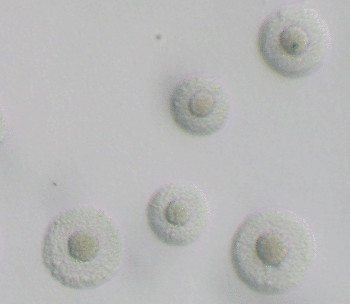Mycoplasma-Like Organism Associated with Common Vaginal Infection
By LabMedica International staff writers
Posted on 18 Apr 2013
A common sexually transmitted infection-causing parasite appears to cultivate bacteria beneficial to it, causing severe symptoms in patients. Posted on 18 Apr 2013
A change in vaginal bacteria causes bacterial vaginosis (BV), and women with this condition are at increased risk of acquiring a Trichomonas vaginalis infection and among such women, there are unique bacterial communities, which would make them more susceptible to infection with the parasite.

Infection Image: Mycoplasma hominis (Photo courtesy of US Centers for Disease Control and Prevention).
Scientists at Louisiana State University (New Orleans, LA, USA) analyzed vaginal samples from 30 T. vaginalis positive (TV+) women and matched them by Nugent score to 30 women who were negative for T. vaginalis (TV-). Equal numbers of normal, intermediate and BV cases were included. The data was collected from 2003 to 2004.
Vaginal microbiota was assessed using 454 pyrosequencing analysis of polymerase chain reaction (PCR)-amplified 16S ribosomal ribonucleic acid (rRNA) gene sequences. The 16S rRNA gene sequence of an unknown organism was obtained by universal bacterial PCR amplification, cloning, and sequencing. The PCR amplicons were cloned using a TOPO TA cloning kit (Life Technologies; Carlsbad, CA, USA).
The investigators discovered that there were two unique bacterial communities that were very strongly associated with trichomonas infection. One of the mycoplasma associated with the unique bacterial community is Mycoplasma hominis, a well-known bacterial pathogen and the other is previously unknown Mycoplasma, called Mnola, and was present in 63% of TV+ infected women. Another organism most strongly associated with TV+ is Parvimonas, a well-known oral pathogen associated with dental root canal infections.
The data indicate that women with trichomonas and this unique bacterial community suffer from worse disease than the other trichomonas-infected women. They have greater amounts of discharge and redness of the vaginal wall. David H. Martin, MD, the senior author of the study said, "We think that this group might also be at especially high risk for infection with human immunodeficiency virus (HIV). So instead of these unique communities predisposing a woman to infection as originally thought, we now believe that trichomonas takes on the role of a farmer in the vaginal environment by cultivating bacterial communities that are in some way beneficial to itself." The study was published on March 15, 2013, in the Journal of Infectious Diseases.
Related Links:
Louisiana State University
Life Technologies













